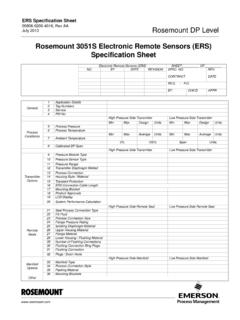Transcription of INSTALLATION AND OPERATING INSTRUCTIONS - Advent …
1 Roof Top Air Conditioner INSTALLATION AND OPERATING INSTRUCTIONS . Ducted system RECORD THIS UNIT INFORMATION FOR FUTURE REFERENCE: Model Number: Serial Number: Date Purchased: This manual must be read and understood before INSTALLATION , adjustment, service, or maintenance is performed. This unit must be installed by a qualified service technician. Modification of this product can be extremely hazardous and could result in personal injury or property damage. INSTALLATION & OPERATING INSTRUCTIONS . These INSTRUCTIONS must stay with the unit Safety INSTRUCTIONS This manual has safety information and INSTRUCTIONS to help users eliminate or reduce the risk of accidents and injuries.
2 Read and follow all safety information, INSTALLATION guides, recommended precautions, and safe OPERATING INSTRUCTIONS . GENERAL INFORMATION. A. This air conditioner is designed for: 1. INSTALLATION on a recreational vehicle. 2. Mounting on the roof of a recreational vehicle. 3. Roof construction with rafters/joists on 16 inch centers. 4. to 5 inch thick roofs. B. The efficiency of the air conditioner will be affected by the conditions inside and outside of the RV. Reducing the heat gain of the RV will allow the air conditioner to function with greater efficiency. Here are some suggestions to reduce heat gain in your RV.
3 1. Select a shaded area to park your RV. 2. Close windows and utilize the blinds and/or curtains. 3. Keep doors shut. 4. Avoid using appliances that produce heat. Beginning the cooling process early in the day will greatly improve the air conditioner's ability to maintain the desired temperature. In high temperature and high humidity environments, the AC should be set in Cool mode with the Fan Speed in the high position. This will allow for optimal cooling efficiency. C. Condensation The manufacturer of this air conditioner will not be responsible for damage caused by condensed moisture on ceilings or other surfaces.
4 Air contains moisture and this moisture tends to condense on cold surfaces. When air enters the RV, condensed moisture may appear on the ceiling, windows, metal parts, etc. The air conditioner removes this moisture from the air during normal operation. Keeping doors and windows closed when this air conditioner is OPERATING will minimize condensation. Fan motor Fan motor Air flow AC circuit COOL Compressor Compressor rated locked (High Refrigerant protection Electrical rated load locked rotor load rotor speed) (R410a) (User Unit dimensions Weight Model BTU/HR Rating (Amps) (Amps) (Amps) (Amps) ( m3/h) (gr.))
5 Size supplied) (in) (lbs). 12 4 12 AWG. AC135 13500 115 VAC 61 580 500 20 Amp " 86. copper 60HZ. up to 1PH. AC150 15000 13 5 66 580 520 24' 20 Amp " 90. 2. Notes: 1. Consult the National Electric Code for proper sizing for wire lengths over 24 ft. 2. When sizing the generator, the total power usage of your recreational vehicle must be considered. Keep in mind generators lose power at high altitudes and from lack of maintenance. 3. CIRCUIT PROTECTION: Time Delay Fuse or HACR Circuit Breakers Required. INSTALLATION INSTRUCTIONS . 1. PRECAUTIONS. A. Read INSTALLATION and OPERATING INSTRUCTIONS carefully before attempting to start your air conditioner INSTALLATION .
6 B. The manufacturer will not be liable for any damages or injury incurred due to failure to follow these INSTRUCTIONS . C. INSTALLATION must comply with the National Electrical Code and any State or Local Codes or regulations. D. DO NOT add any devices or accessories to this air conditioner except those specifically authorized by manufacturer. E. This equipment must be serviced by qualified personnel and some states require licensed personnel. 2. CHOOSING A LOCATION FOR THE AIR CONDITIONER. This product is designed for use as a RV roof top air conditioner. The use of this product in other applications will void the manufactures warranty.
7 A. NORMAL LOCATIONS: The air conditioner is designed to fit over an existing roof vent opening. When the vent is removed, it normally creates a 14-1/4" x 14-1/4" 1/8 opening. B. OTHER LOCATIONS: When a roof vent is not available or another location is desired, the following is recommended: 3. 1. For one unit INSTALLATION : The air conditioner should be mounted slightly forward of center (front to back) and centered from side to side. See Figure 1. Figure 1. 2. For two unit INSTALLATION : Install one air conditioner 1/3 distance and the other air conditioner 2/3's from front of RV and centered from side to side.
8 See Figure 2. Figure 2. It is preferred that this air conditioner be installed in a relatively flat and level roof section measured with the RV parked on a level surface; however, up to 15 slant to either side, or front-to-back is acceptable. 4. C. POST LOCATION SELECTION: 1. Check for obstructions in the area where air conditioner will be installed. 2. The roof must be capable of supporting 130lbs while the RV is in motion. Normally, a 200 lb. static load design will meet this requirement. 3. ROOF PREPARATION. A. EXISTING ROOF VENT REMOVAL: 1. Unscrew and remove the roof vent. 2. Remove all caulking compound around opening.
9 3. Seal all screw holes and seams where the roof gasket will be located. Use a good grade of all weather sealant. B. NEW OPENING: 1. A 14-1/4" x 14-1/4" 1/8 opening must be cut through the roof and ceiling of the RV. It is recommended this opening be located between roof framework. 2. Mark a 14-1/4" x 14-1/4" square on the roof and carefully cut the opening. 3. Using the roof opening as a guide, cut the matching hole in the ceiling. See 5. C. OPENING PREPARATION: 1. If the opening exceeds 14-3/8" x 14-3/8", it will be necessary to install spacers. 2. If the opening is less than 14-1/8" x 14-1/8", it must be enlarged.
10 3. Route a 12/3 Romex type supply line from the fuse or circuit breaker box to the front of roof opening. a. The power supply must be on a separate 20 amp Time Delay Fuse or HACR. Circuit Breaker. b. Wiring must comply with all National, State and Local wiring codes. c. Make sure at least 15" of wire extend into the roof opening to ensure easy connections. 4. The opening must be framed to provide adequate support and prevent air from being drawn from the roof cavity. Lumber 3/4" thick or more and long enough to bridge the opening must be used. Remember to provide an entrance hole in the front of the opening for 110v, 12v, and thermostat wires.








